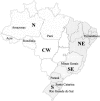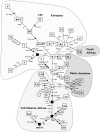The ancestry of Brazilian mtDNA lineages
- PMID: 10873790
- PMCID: PMC1287189
- DOI: 10.1086/303004
The ancestry of Brazilian mtDNA lineages
Erratum in
- Am J Hum Genet 2000 Sep;67(3):775
Abstract
We have analyzed 247 Brazilian mtDNAs for hypervariable segment (HVS)-I and selected restriction fragment-length-polymorphism sites, to assess their ancestry in different continents. The total sample showed nearly equal amounts of Native American, African, and European matrilineal genetic contribution but with regional differences within Brazil. The mtDNA pool of present-day Brazilians clearly reflects the imprints of the early Portuguese colonization process (involving directional mating), as well as the recent immigrant waves (from Europe) of the last century. The subset of 99 mtDNAs from the southeastern region encompasses nearly all mtDNA haplogroups observed in the total Brazilian sample; for this regional subset, HVS-II was analyzed, providing, in particular, some novel details of the African mtDNA phylogeny.
Figures


References
Electronic-Database Information
-
- GenBank Overview, http://www.ncbi.nlm.nih.gov/Genbank/GenbankOverview.html (for HVS-I [accession numbers AF243627–AF243796] and HVS-II [accession numbers AF243539–AF243626])
-
- Instituto Brasileiro de Geografia Estatística, http://www.ibge.gov.br/
References
-
- Alves-Silva J, Guimarães PE, Rocha J, Pena SD, Prado VF (1999) Identification in Portugal and Brazil of a mtDNA lineage containing a 9-bp triplication of the intergenic COII/tRNALys region. Hum Hered 49:56–58 - PubMed
-
- Andrews RM, Kubacka I, Chinnery PF, Lightowlers RN, Turnbull DM, Howell N (1999) Reanalysis and revision of the Cambridge reference sequence for human mitochondrial DNA. Nat Genet 23:147 - PubMed
-
- Arpini-Sampaio Z, Costa MC, Melo AA, Carvalho MF, Deus MS, Simões AL (1999) Genetic polymorphisms and ethnic admixture in African-derived black communities of northeastern Brazil. Hum Biol 71:69–85 - PubMed
Publication types
MeSH terms
Substances
Associated data
- Actions
- Actions
- Actions
- Actions
- Actions
- Actions
- Actions
- Actions
- Actions
- Actions
- Actions
- Actions
- Actions
- Actions
- Actions
- Actions
- Actions
- Actions
- Actions
- Actions
- Actions
- Actions
- Actions
- Actions
- Actions
- Actions
- Actions
- Actions
- Actions
- Actions
LinkOut - more resources
Full Text Sources
Other Literature Sources
Molecular Biology Databases

